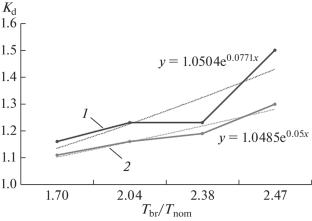Evaluation of Dynamic Parameters and Improvement of Wear Resistance of Involute Gears when Using Film-Forming Lubricants
Abstract—
The article describes the problems of existing methods for assessing the durability of involute gears (IGs) associated with determining the maximum permissible wear and predicting the occurrence of sudden failure. The relationship of dynamic indicators with wear processes in IGs is described, which makes it possible to predict resource limitation by the nature of the growth of the dynamic coefficient due to the increase in the probability of jamming. The results of the analysis of the amplitude-frequency response of the transmission by the fast Fourier transform method are presented, which allowed us not only to evaluate the dynamism of the transmission with different lubricants, but also to rank these materials by their extreme pressure action depending on the magnitude of the loading moment, at a given limit value of the dynamic coefficient. It is shown that as the antifriction properties of the lubricant increase, the growth of the dynamism coefficient decreases as the loading moment increases (when using a film-forming additive, the limiting value of the dynamism coefficient is reached at a loading torque of 2.47 N m, and in the case of using pure synthetic oil, the limiting value of the dynamism coefficient is reached at a loading torque of 2.39 N m), this in turn leads to an increase in the maximum permissible wear and to an increase in the resource according to the wear criterion (in the case of using synthetic oil with a film-forming additive, the IG resource is 10–11 times higher than in the case of using pure synthetic oil).The dependence of the amplitude of the torque oscillations on the high-speed shaft of the IG transmission on the type of lubricant is revealed. Analytical dependences of the dynamic coefficient on the load for different lubricants are obtained. The dependence of the wear limit on the type of lubricant is proposed. A new method of predicting the resource of an IG is proposed taking into account the growth of the dynamic coefficient.


 求助内容:
求助内容: 应助结果提醒方式:
应助结果提醒方式:


